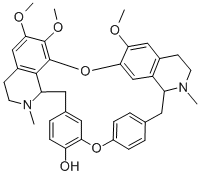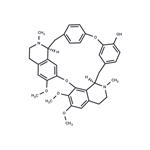Berbamine is an alkaloid, separated from Berberidaceae, Menispermaceae, or
Ranunculaceae plants. Most of Berberidaceae plants have medicinal value, including their root, root bark, and stem. The plants of Berberis L. and Mahonia Nutt.
contain many alkaloids, the most important of which are berberine and a small
amount of palmatine, jatrorrhizine, berbamine, oxyacanthine, and so on. These
compounds have many biological activities and have been used to replace goldthread and golden cypress. Also they are well succedaneums of berberine in Chinese
and Western medicine. Traditional Chinese medicine Oregon grape root has different therapeutic effects for dysentery, enteritis, children pneumonia, and chronic
bronchitis. The major treatment diseases of Chinese mahonia are bacillary dysentery, acute gastritis, infectious hepatitis, pneumonia, tuberculosis, bronchitis, sore
throat, and so on.
Appearance: odorless and bitter white crystalline, powder, belongs to bisbenzylisoquinoline alkaloid. Melting point: 197–210?°C in petroleum ether. Solubility: easily
soluble in dilute hydrochloric acid, sulfuric acid, ethanol, chloroform, and acetone;
soluble in ether; slightly soluble in boiling water and petroleum ether; but insoluble
in cold water, ammonia, sodium carbonate, and calcium hydroxide solution.
Berbamine is an alkaloid mainly from Berberis julianae, Berberis wilsonae,
Berberis poiretii, and huanglumu, which belong to Berberidaceae berberis and
Mahonia. Nowadays, it mainly comes from chemical synthesis. Berbamine hydrochloride is contained in the 13th volume of the book, Hua xue yao ping di biao
sheng guo biao. As early as 1940, the United States scholars had obtained berbamine from Mahonia . Chinese scholars began the research of berbamine
extraction and pharmacological activities since the 1980s in the last century .
Although the berbamine study in our country later than the west, the traditional
Chinese medicine Berberi’s medicinal records can be traced back to the Tang
Dynasty. The book Tang Ben Cao recorded that Oregon grape root could be a therapy for aphtha, kill insects, and remove hot gas in the body. In the Ming Dynasty the
book Ben Cao Gang Mu recorded that Oregon grape root could treat metrorrhagia.
Now, berbamine is widely used for leukopenia.
antihypertensive, skeletal muscle relaxant
ChEBI: Berbamine is a member of isoquinolines and a bisbenzylisoquinoline alkaloid.
Berbamine is contained in the 13th volume of the book, National Standards for
Chemical Drugs.
The current clinical dosage is berbamine hydrochloride tablets. It is used in the
prevention and treatment of patients with cancer, which is due to radiotherapy- and
chemotherapy-induced neutropenia or due to benzene poisoning, radioactive substances, and drug-induced neutropenia.
Berbamine can promote hematopoietic function, stimulate myeloid proliferation.
Also berbamine can enhance the content of hematopoietic stem cell and
granulocyte-colony stimulating factor (G-CSF), then increase the proliferation and
differentiation of bone marrow hematopoietic stem cells and granule progenitor
cell, which increase the number of peripheral blood leukocytes. Preclinical and
clinical studies showed that berbamine was good for the treatment of leukopenia
induced by chemotherapy. Berbamine can inhibit the proliferation of many kinds of
tumor cells, such as the human high metastatic breast cancer cells MDA-MB-231,
non-small cell lung cancer cells A549, liver cancer cells SMMC772l and HepG2,
multiple myeloma cells KM3 and RPMl8226, chronic myeloid leukemia (CML)
cells KU812, and imatinib-resistant K562 cells .
Berbamine is used for the prevention and treatment of cancer patients with neutropenia due to radiotherapy, chemotherapy , benzene poisoning, radioactive substances, and drug.
This antihypertensive alkaloid (FW = 608.72 g/mol; CAS 478-61-5; Symbol: BBM) from Berberis lyceum and Mahonia swaseyi is a dihydropyridine�class calcium ion blocker. Berbamine also inhibits KM3 cell growth by inducing G1 arrest as well as apoptosis, by blocking NF-kB signaling through up-regulation of A20, down-regulation of IKKa, p-IkBa, and then inhibition of p65 nuclear translocation, all with a resultant decrease in the expression of the downstream targets of NF- kB. BBM potently suppresses liver cancer cell proliferation and induces cancer cell death by targeting Ca2+/calmodulin-dependent protein kinase II (CAMKII). BBM likewise inhibits in vivo tumorigenicity of liver cancer cells in NOD/SCID mice. These effects are recapitulated by short hairpin RNA-mediated CAMKII knockdown, whereas CAMKII overexpression promotes cancer cell proliferation and increases the resistance of liver cancer cells to BBM. CAMKII was hyperphosphorylated in liver tumors compared with the paired peri-tumor tissues, supporting a role of CAMKII in promoting human liver cancer progression and the clinical potential of BBM in liver cancer therapies.
Crystallise berbamine from pet ether or *C6H6 (with 1*C6H6 m 129-134o). [Bick Aust J Chem 9 111, 118 1956, Beilstein 27 II 891, 27 III/IV 8732.]



